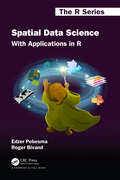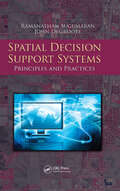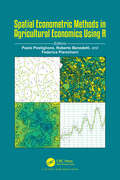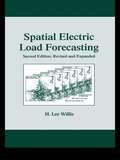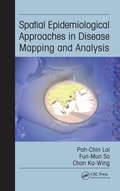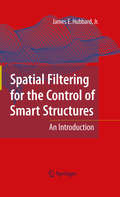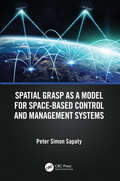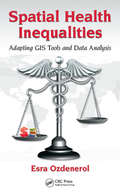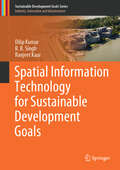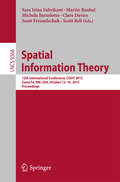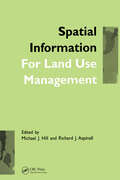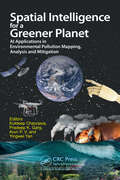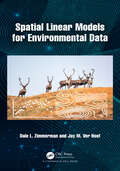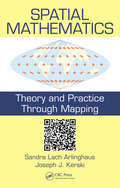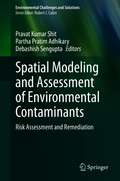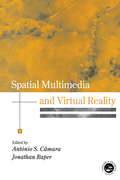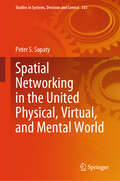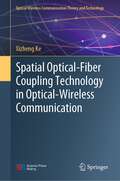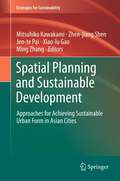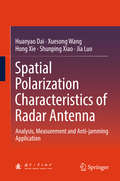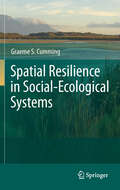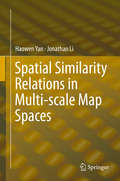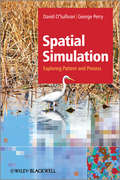- Table View
- List View
Spatial Data Science: With Applications in R (Chapman & Hall/CRC The R Series)
by Roger Bivand Edzer PebesmaSpatial Data Science introduces fundamental aspects of spatial data that every data scientist should know before they start working with spatial data. These aspects include how geometries are represented, coordinate reference systems (projections, datums), the fact that the Earth is round and its consequences for analysis, and how attributes of geometries can relate to geometries. In the second part of the book, these concepts are illustrated with data science examples using the R language. In the third part, statistical modelling approaches are demonstrated using real world data examples. After reading this book, the reader will be well equipped to avoid a number of major spatial data analysis errors. The book gives a detailed explanation of the core spatial software packages for R: sf for simple feature access, and stars for raster and vector data cubes – array data with spatial and temporal dimensions. It also shows how geometrical operations change when going from a flat space to the surface of a sphere, which is what sf and stars use when coordinates are not projected (degrees longitude/latitude). Separate chapters detail a variety of plotting approaches for spatial maps using R, and different ways of handling very large vector or raster (imagery) datasets, locally, in databases, or in the cloud. The data used and all code examples are freely available online from https://r-spatial.org/book/. The solutions to the exercises can be found here: https://edzer.github.io/sdsr_exercises/.
Spatial Decision Support Systems: Principles and Practices
by Ramanathan Sugumaran John DegrooteThis book provides a comprehensive examination of the various aspects of SDSS evolution, components, architecture, and implementation. Integrating research from a variety of disciplines, it supplies a complete overview of SDSS technologies and their application. This groundbreaking reference provides thorough coverage of the roots of SDSS. It explains the core principles of SDSS, how to use them in various decision making contexts, and how to design and develop them using readily available enabling technologies and commercial tools.
Spatial Econometric Methods in Agricultural Economics Using R
by Paolo PostiglioneModern tools, such as GIS and remote sensing, are increasingly used in the monitoring of agricultural resources. The developments in GIS technology offer growing opportunities to agricultural economics analysts dealing with large and detailed spatial databases, allowing them to combine spatial information from different sources and to produce different models. The availability of these valuable sources of information makes the advanced models suggested in the spatial statistic and econometric literature applicable to agricultural economics. This book aims at supporting stakeholders to design spatial surveys for agricultural data and/or to analyse the geographically collected data. This book attempts to describe the main typology of agricultural data and the most appropriate methods for the analysis, together with a detailed description of the available data sources and their collection methods. Topics such as spatial interpolation, point patterns, spatial autocorrelation, survey data analysis, small area estimation, regional data modelling, and spatial econometrics techniques are covered jointly with issues arising from the integration of several data types. The theory of spatial methods is complemented by real and/or simulated examples implemented through the open-source software R.
Spatial Electric Load Forecasting (Power Engineering (willis) Ser. #Vol. 18)
by H. Lee WillisContaining 12 new chapters, this second edition offers increased coverage of weather correction and normalization of forecasts, anticipation of redevelopment, determining the validity of announced developments, and minimizing risk from over- or under-planning. It provides specific examples and detailed explanations of key points to consider for both standard and unusual utility forecasting situations, information on new algorithms and concepts in forecasting, a review of forecasting pitfalls and mistakes, case studies depicting challenging forecast environments, and load models illustrating various types of demand.
Spatial Epidemiological Approaches in Disease Mapping and Analysis
by Poh-Chin Lai Fun-Mun So Ka-Wing ChanContaining method descriptions and step-by-step procedures, the Spatial Epidemiological Approaches in Disease Mapping and Analysis equips readers with skills to prepare health-related data in the proper format, process these data using relevant functions and software, and display the results as mapped or statistical summaries. Describing the wide r
Spatial Filtering for the Control of Smart Structures
by James E. HubbardThis book develops and details rigorous design methodologies and performance measures for the control of modern Smart Structures. The spatially distributed/continuum or distributed parameter nature of such structures makes it difficult to apply modern lumped parameter control philosophy and techniques to such designs. While there exist a substantial amount of technical literature on the Control of Distributed Parameter Systems (DPS), there are still relatively few applications or practical implementations of the theory. The work presented in this textbook address the issue of the design and implementation of distributed parameter control schemes, for Smart Structures, which exploit both spatially distributed sensing and actuation through the use of modern smart material technology. The merging of DPS with distributed parameter transducers leads to simple, physically realizable control system designs. This text provides a significant reference for practicing professionals, students and researchers in the area of transducer design using smart materials for high performance smart structures.
Spatial Grasp as a Model for Space-based Control and Management Systems
by Peter Simon SapatyGovernmental agencies and private companies of different countries are actively moving into space around Earth with the aim to provide smart communication and industry, security, and defense solutions. This often involves massive launches of small, cheap satellites in low earth orbits, which is also contributing to the growth of space debris. The book offers a high-level holistic system philosophy, model, and technology that can effectively organize distributed space-based systems, starting with their planning, creation, and growth. The Spatial Grasp Technology described in the book, based on parallel navigation and pattern-matching of distributed environments with high-level recursive mobile code, can effectively provide any networking protocols and important system applications, by integrating and tasking available terrestrial and celestial equipment. This book contains practical examples of technology-based solutions for tracing hypersonic gliders, continuing observation of certain objects and infrastructures on Earth from space, space-based command and control of large distributed systems, as well as collective removal of increasing amounts of space junk. Earlier versions of this technology were prototyped and used in different countries, with the current version capable of being quickly implemented in traditional industrial or even university environments. This book is oriented toward system scientists, application programmers, industry managers, and university students interested in advanced MSc and PhD projects related to space conquest and distributed system management. Dr Peter Simon Sapaty, Chief Research Scientist, Ukrainian Academy of Sciences, has worked with networked systems for five decades. Outside of Ukraine, he has worked in the former Czechoslovakia (now Czech Republic and Slovakia), Germany, the UK, Canada, and Japan as a group leader, Alexander von Humboldt researcher, and invited and visiting professor. He launched and chaired the Special Interest Group (SIG) on Mobile Cooperative Technologies in Distributed Interactive Simulation project in the United States, and invented a distributed control technology that resulted in a European patent and books with Wiley, Springer, and Emerald. He has published more than 250 papers on distributed systems and has been included in the Marquis Who’s Who in the World and Cambridge Outstanding Intellectuals of the 21st Century. Peter also works with several international scientific journals.
Spatial Health Inequalities: Adapting GIS Tools and Data Analysis
by Esra OzdenerolThe neighborhoods and the biophysical, political, and cultural environments all play a key role in affecting health outcomes of individuals. Unequal spatial distribution of resources such as clinics, hospitals, public transportation, fresh food markets, and schools could make some communities as a whole more vulnerable and less resilient to adverse health effects. This somber reality suggests that it is rather the question of "who you are depends upon where you are" and the fact that health inequality is both a people and a place concern. That is why health inequality needs to be investigated in a spatial setting to deepen our understanding of why and how some geographical areas experience poorer health than others. This book introduces how spatial context shapes health inequalities. Spatial Health Inequalities: Adapting GIS Tools and Data Analysis demonstrates the spatial health inequalities in six most important topics in environmental and public health, including food insecurity, birth health outcomes, infectious diseases, children’s lead poisoning, chronic diseases, and health care access. These are the topics that the author has done extensive research on and provides a detailed description of the topic from a global perspective. Each chapter identifies relevant data and data sources, discusses key literature on appropriate techniques, and then illustrates with real data with mapping and GIS techniques. This is a unique book for students, geographers, clinicians, health and research professionals and community members interested in applying GIS and spatial analysis to the study of health inequalities.
Spatial Inequalities
by Allan G. Hill Justin Stoler John R. WeeksThis book provides a fresh analysis of the demography, health and well-being of a major African city. It brings a range of disciplinary approaches to bear on the pressing topics of urban poverty, urban health inequalities and urban growth. The approach is primarily spatial and includes the integration of environmental information from satellites and other geospatial sources with social science and health survey data. The authors Ghanaians and outsiders, have worked to understand the urban dynamics in this burgeoning West African metropolis, with an emphasis on urban disparities in health and living standards. Few cities in the global South have been examined from so many different perspectives. Our analysis employs a wide range of GIScience methods, including analysis of remotely sensed imagery and spatial statistical analysis, applied to a wide range of data, including census, survey and health clinic data, all of which are supplemented by field work, including systematic social observation, focus groups, and key informant interviews. This book aims to explain and highlight the mix of methods, and the important findings that have been emerging from this research, with the goal of providing guidance and inspiration for others doing similar work in cities of other developing nations.
Spatial Information Technology for Sustainable Development Goals (Sustainable Development Goals Series)
by Dilip Kumar R.B. Singh Ranjeet KaurThis textbook aims to develop a scientific knowledge base on spatial information technology to communicate the United Nations' Sustainable Development Goals (SDGs) among students, researchers, professionals and laymen. The book improves understanding of the spatial database and explains how to extract information from this for planning purposes. To enhance the knowledge of geoscientists and environmentalists, the book describes the basic fundamental concepts to advance techniques for spatial data management and analysis and discusses the methodology. The Geographic Information System (GIS), remote sensing and Global Positioning System (GPS) are presented in an integrated manner for the planning of resources and infrastructure. The management of these systems is discussed in a very lucid way to develop the reader's skills. The proper procedure for map making and spatial analysis are included along with case studies to the reader. Where the first part of the book discusses the conceptual background, the second part deals with case studies using these applications in different disciplines. The presented case studies include land use, agriculture, flood, watershed characterization and infrastructure assessment for the Sustainable Development Goals.
Spatial Information Theory
by Martin Raubal Sara Irina Fabrikant Michela Bertolotto Clare Davies Scott Freundschuh Scott BellThis book constitutes the proceedings of the 12th International Conference on Spatial Information Theory, COSIT 2015, held in Santa Fee, NM, USA, in October 2015. The 22 papers presented in this book were carefully reviewed and selected from 52 full paper submissions. The following topics are addressed: formalizing and modeling space-time, qualitative spatio-temporal reasoning and representation, language and space, signs, images, maps, and other representations of space, navigations by humans and machines.
Spatial Information for Land Use Management
by Michael J. Hill Richard J. AspinallGeographic Information Systems (GIS), Remote Sensing, and environmental modelling are increasingly being used to address land use and land use management issues although much of the development in these applications is based in specific case studies that are not readily accessible to a wide audience. Spatial Information for Land Use Management is d
Spatial Intelligence for a Greener Planet: AI Applications in Environmental Pollution Mapping, Analysis and Mitigation
by Pradeep K. Garg Kuldeep Chaurasia P. V. Arun Yingwei YanWith rapid advancements in AI, this book reveals how AI can be a powerful tool in reducing pollution and fostering sustainability. It highlights the integration of geospatial techniques with AI for enhancing capabilities in mapping, analysis, and mitigation of environmental pollution. Starting with foundational concepts in AI, geospatial technology, and pollution, the book addresses air, water, soil and thermal pollution, emphasizing their harmful impacts. Through real-world case studies and advanced research, it showcases AI and geospatial technology's revolutionary role in pollution mitigation, exploring AI-driven sensors, satellite imagery, and associated networks for precise and efficient pollution monitoring and management.
Spatial Linear Models for Environmental Data (Chapman & Hall/CRC Applied Environmental Statistics)
by Dale L. Zimmerman Jay M. Ver HoefMany applied researchers equate spatial statistics with prediction or mapping, but this book naturally extends linear models, which includes regression and ANOVA as pillars of applied statistics, to achieve a more comprehensive treatment of the analysis of spatially autocorrelated data. Spatial Linear Models for Environmental Data, aimed at students and professionals with a master’s level training in statistics, presents a unique, applied, and thorough treatment of spatial linear models within a statistics framework. Two subfields, one called geostatistics and the other called areal or lattice models, are extensively covered. Zimmerman and Ver Hoef present topics clearly, using many examples and simulation studies to illustrate ideas. By mimicking their examples and R code, readers will be able to fit spatial linear models to their data and draw proper scientific conclusions. Topics covered include: Exploratory methods for spatial data including outlier detection, (semi)variograms, Moran’s I, and Geary’s c. Ordinary and generalized least squares regression methods and their application to spatial data. Suitable parametric models for the mean and covariance structure of geostatistical and areal data. Model-fitting, including inference methods for explanatory variables and likelihood-based methods for covariance parameters. Practical use of spatial linear models including prediction (kriging), spatial sampling, and spatial design of experiments for solving real world problems. All concepts are introduced in a natural order and illustrated throughout the book using four datasets. All analyses, tables, and figures are completely reproducible using open-source R code provided at a GitHub site. Exercises are given at the end of each chapter, with full solutions provided on an instructor’s FTP site supplied by the publisher.
Spatial Mathematics: Theory and Practice through Mapping
by Joseph J. Kerski Sandra Lach ArlinghausIn terms of statistics, GIS offers many connections. With GIS, data are gathered, displayed, summarized, examined, and interpreted to discover patterns. Spatial Mathematics: Theory and Practice through Mapping uses GIS as a platform to teach mathematical concepts and skills through visualization of numbers. It examines theory and practice from disp
Spatial Modeling and Assessment of Environmental Contaminants: Risk Assessment and Remediation (Environmental Challenges and Solutions)
by Debashish Sengupta Pravat Kumar Shit Partha Pratim AdhikaryThis book demonstrates the measurement, monitoring and mapping of environmental contaminants in soil & sediment, surface & groundwater and atmosphere. This book explores state-of-art techniques based on methodological and modeling in modern geospatial techniques specifically focusing on the recent trends in data mining techniques and robust modeling. It also presents modifications of and improvements to existing control technologies for remediation of environmental contaminants. In addition, it includes three separate sections on contaminants, risk assessment and remediation of different existing and emerging pollutants. It covers major topics such as: Radioactive Wastes, Solid and Hazardous Wastes, Heavy Metal Contaminants, Arsenic Contaminants, Microplastic Pollution, Microbiology of Soil and Sediments, Soil Salinity and Sodicity, Aquatic Ecotoxicity Assessment, Fluoride Contamination, Hydrochemistry, Geochemistry, Indoor Pollution and Human Health aspects. The content of this book will be of interest to researchers, professionals, and policymakers whose work involves environmental contaminants and related solutions.
Spatial Multimedia and Virtual Reality
by Antonio S. CamaraThe intersection of two disciplines and technologies which have become mature academic research topics in the 1990s was destined to be a dynamic area for collaboration and publication. However, until now no significant book-length treatment of the meeting of GIS and Virtual Reality has been available. This volume puts that situation to rights by bringing these together to cement some common understanding and principles in a potentially highly promising area for technological collaboration and cross-fertilisation. The result is a volume which ranges in subject matter from studies of a Virtual GIS Room to Spatial Agents, and from an Environmental Multimedia System to Computer-Assisted 3D Geographic Education. All the contributors are well-known international scientists, principally from the computational side of GIS. It will be a valuable resource for any GIS researcher or professional looking to understand the leading edge of this fertile field.
Spatial Networking in the United Physical, Virtual, and Mental World (Studies in Systems, Decision and Control #533)
by Peter S. SapatyThe current book chooses graphs and networks as primary and global research objectives after reviewing different types and areas of networking and existing works on graph and network operations. The ideas of this book originate from the WAVE approach which allowed us, more than half a century ago, to implement citywide heterogeneous computer networks and solve distributed problems on them in flexible and mobile way. The invented management paradigm evolved into Spatial Grasp Technology resulted in European patent and nine previous books oriented on concrete applications in social and defense systems, security, crises management, collective robotics, space research, and others. Many obtained results were dealing with graph and network structures and problems which were extremely important in the researched areas. It aims at development of higher-level social infrastructures effectively integrating different types of networking under the same universal approach, also application of networking in new areas like organoids and brain research. This book is oriented toward system scientists, application programmers, industry managers, university students, philosophers, psychologists, and United Nations personnel too.
Spatial Observation of Giant Panda Habitat: Techniques and Methods
by Xinyuan Wang Jing Zhen Qingkai MengThis book evaluates the past, present, and future habitat suitability of giant pandas based on spatial observation technology involving optical remote sensing, microwave remote sensing, and LiDAR to discover the mysterious ecological environment of giant panda habitat. Considering the problems faced by the world natural heritage site protection, it takes the world natural heritage site “Sichuan Giant Panda Sanctuaries – Wolong, Mt Siguniang and Jiajin Mountains” as the research area, exemplifies systematically the various techniques and methodologies of spatial information technology for monitoring, evaluation, and prediction of rare and endangered species habitats, and provides scientific suggestions for sustainable development of giant panda habitat based on a series of comprehensive case analysis at Wolong national nature reserve and Ya'an prefecture, Sichuan province, China. The book serves both as a textbook in the field of natural heritage protection, remote sensing, and GIS application, as well as a reference for managing natural heritage sites.
Spatial Optical-Fiber Coupling Technology in Optical-Wireless Communication (Optical Wireless Communication Theory and Technology)
by Xizheng KeThis book analyzes the development of space light-fiber coupling research, highlights its importance, examines the underlying theory and key problems, and elaborates on methods to improve the space light-fiber coupling efficiency. Starting from the basic theory of electromagnetic field, the transmission characteristics of light in optical fibers are expounded, and the coupling characteristics of optical signals of different modes are investigated. The spatial light-fiber coupling techniques such as mode conversion method, lens coupling method, and wavefront distortion correction method are discussed in detail, and the key technologies involved are verified by experiments. This book is suitable for the vast majority of engineering and technical personnel and teachers in colleges and institutions who are engaged in wireless optical communication. It can also be used to train senior undergraduates and graduate students in relevant fields.
Spatial Planning and Sustainable Development
by Ming Zhang Jen-Te Pai Mitsuhiko Kawakami Xiao-Lu Gao Zhen-Jiang ShenThis book attempts to provide insights into the achievement of a sustainable urban form, through spatial planning and implementation; here, we focus on planning experiences at the levels of local cities and some metropolitan areas in Asian countries. This book investigates the impact of planning policy on spatial planning implementation, from multidisciplinary viewpoints encompassing land-use patterns, housing development, transportation, green design, and agricultural and ecological systems in the urbanization process. We seek to learn from researchers in an integrated multidisciplinary platform that reflects a variety of perspectives, such as economic development, social equality, and ecological protection, with a view to achieving a sustainable urban form.
Spatial Polarization Characteristics of Radar Antenna: Analysis, Measurement and Anti-jamming Application
by Hong Xie Jia Luo Huanyao Dai Xuesong Wang Shunping XiaoThis book presents novel research ideas and offers insights into radar system design, artificial intelligence and signal processing applications. Further, it proposes a new concept of antenna spatial polarization characteristics (SPC), suggesting that the antenna polarization is a function of the spatial direction and providing new ideas for radar signal processing (RSP) and anti-jamming. It also discusses the design of an advanced signal-processing algorithm, and proposes new polarimetric and anti-jamming methods using antenna inherent properties. The book helps readers discover the potential of radar information processing and improve its anti-interference and target identification ability. It is of interest to university researchers, radar engineers and graduate students in computer science and electronics who wish to learn the core principles, methods, algorithms, and applications of RSP.
Spatial Resilience in Social-Ecological Systems
by Graeme S. CummingSpatial Resilience is a new and exciting area of interdisciplinary research. It focuses on the influence of spatial variation - including such things as spatial location, context, connectivity, and dispersal - on the resilience of complex systems, and on the roles that resilience and self-organization play in generating spatial variation. Prof. Cumming provides a readable introduction and a first comprehensive synthesis covering the core concepts and applications of spatial resilience to the study of social-ecological systems. The book follows a trajectory from concepts through models, methods, and case study analysis before revisiting the central problems in the further conceptual development of the field. In the process, the author ranges from the movements of lions in northern Zimbabwe to the urban jungles of Europe, and from the collapse of past societies to the social impacts of modern conflict. The many case studies and examples discussed in the book show how the concept of spatial resilience can generate valuable insights into the spatial dynamics of social-ecological systems and contribute to solving some of the most pressing problems of our time. Although it has been written primarily for students, this book will provide fascinating reading for interdisciplinary scientists at all career stages as well as for the interested public. "Graeme Cumming, central in the development of resilience thinking and theory, has produced a wonderful book on spatial resilience, the first ever on this topic. The book will become a shining star, a classic in the explosion of new ideas and approaches to studying and understanding social-ecological systems." Carl Folke, Stockholm Resilience Centre, Sweden
Spatial Similarity Relations in Multi-scale Map Spaces
by Haowen Yan Jonathan LiHow does one determine how similar two maps are? This book aims at the theory of spatial similarity relations and its application in automated map generalization, including the definitions, classification and features of spatial similarity relations. Included also are calculation models of spatial similarity relations between arbitrary individual objects and between arbitrary object groups, and the application of the theory in the automation of the algorithms and procedures in map generalization.
Spatial Simulation
by David O'Sullivan George L. PerryA ground-up approach to explaining dynamic spatial modelling for an interdisciplinary audience.Across broad areas of the environmental and social sciences, simulation models are an important way to study systems inaccessible to scientific experimental and observational methods, and also an essential complement to those more conventional approaches. The contemporary research literature is teeming with abstract simulation models whose presentation is mathematically demanding and requires a high level of knowledge of quantitative and computational methods and approaches. Furthermore, simulation models designed to represent specific systems and phenomena are often complicated, and, as a result, difficult to reconstruct from their descriptions in the literature. This book aims to provide a practical and accessible account of dynamic spatial modelling, while also equipping readers with a sound conceptual foundation in the subject, and a useful introduction to the wide-ranging literature.Spatial Simulation: Exploring Pattern and Process is organised around the idea that a small number of spatial processes underlie the wide variety of dynamic spatial models. Its central focus on three 'building-blocks' of dynamic spatial models - forces of attraction and segregation, individual mobile entities, and processes of spread - guides the reader to an understanding of the basis of many of the complicated models found in the research literature. The three building block models are presented in their simplest form and are progressively elaborated and related to real world process that can be represented using them. Introductory chapters cover essential background topics, particularly the relationships between pattern, process and spatiotemporal scale. Additional chapters consider how time and space can be represented in more complicated models, and methods for the analysis and evaluation of models. Finally, the three building block models are woven together in a more elaborate example to show how a complicated model can be assembled from relatively simple components.To aid understanding, more than 50 specific models described in the book are available online at patternandprocess.org for exploration in the freely available Netlogo platform. This book encourages readers to develop intuition for the abstract types of model that are likely to be appropriate for application in any specific context. Spatial Simulation: Exploring Pattern and Process will be of interest to undergraduate and graduate students taking courses in environmental, social, ecological and geographical disciplines. Researchers and professionals who require a non-specialist introduction will also find this book an invaluable guide to dynamic spatial simulation.
